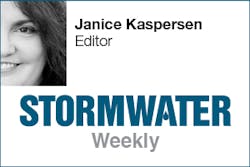
Has your city banned plastic bags yet? Is it thinking about doing so? If so, chances are the bill owes something to Jennie Romer, an attorney who has become known as the country’s expert in plastic-bag legislation.
We’ve often discussed in Stormwater magazine and online the problems with plastics, including plastic bags and other items in the waterways and oceans. Close to home, they can clog storm drains and create an unsightly litter problem. Farther away, they are ingested by marine animals and birds, which sometimes starve to death as a result. Most everyone, by now, is aware of the large accumulations, or gyres, of plastics and other debris in the oceans. Most everyone agrees something should be done. But still, bag bans are often unpopular with consumers; the things are just so darned convenient, after all.
Unpopular as they sometimes are, the bans are spreading throughout the country. In 2007 San Francisco was the first city in the US to ban single-use plastic bags, followed by San Jose, and, in 2012, Los Angeles. Romer was involved in each of those cases. Now she has moved to New York City, which is considering a bill of its own; a decision from the city council could come as early as this month. She believes a victory in the largest city in the US will influence similar decisions throughout the country.
New York’s legislation, though, isn’t an out-and-out ban. Instead, it would charge consumers a five-cent fee on both plastic and paper bags. There are important differences between banning bags outright and charging a fee for them—typically five or ten cents per bag in places that have adopted that strategy. Romer notes that fees are easier to defend in court than bans, and they allow consumers to choose: If you really, really need the bag, you have the option to buy it.
There are some impressive success stories with both tactics—bans and fees. Washington DC has a five-cent-per-bag fee and estimates that it has reduced bag litter in the surrounding rivers by 66%. After its ban, San Jose saw an 89% reduction in plastic bags in its storm drains. Many cities and countries outside the US are also getting on board. China placed a ban on certain types of plastic bags in 2008 and reckons it has eliminated the use of 40 billion bags a year since then. Uganda has a ban, and so does Mumbai. Since a 15-(Euro) cent per bag fee was imposed in Ireland in 2002, use of plastic bags has fallen there by 94%.
Besides consumers’ objections, though, a big obstacle to banning bags is opposition from the plastics and packaging industries, which sometimes spend serious money to help defeat proposed laws, arguing that the bans aren’t necessary and are perhaps even counterproductive. In this article about Romer, for example, the senior director of a retail-packaging manufacturer—and an opponent of the New York bill—makes some convincing-sounding arguments about how easy it is to recycle the bags when cities cooperate.
Still another argument is that fees, in particular, place an unfair burden on the poorest consumers. A counter to that argument is that the bags aren’t actually free now—the store passes along their cost to consumers in other, less obvious ways. And many people believe that reusable bags will catch on anyplace bans or fees go into effect; some companies are happy to supply those bags for free as long as they can brand them with their own logo or advertising.
As Romer notes in the article, speaking of her decision to pursue this type of legislation, “The issue of climate change seemed so enormous to me, not something I could really affect. But I did think I could do something about plastic bags.”
What about you? Do you think this is an important battle in the quest for clean water, or would you rather spend time and energy on other measures?Continuing Education Credits From Forester University
Wednesday, May 4: Designing Effective Construction Sediment Containment Systems
This webinar is Module 3 of the Sediment & Erosion Control for Construction Sites Master Class Series, presented by Jerald S. Fifield and Tina Evans. If you’ve missed the earlier sessions, you can see them as on-demand webcasts. Click here for more information and to register.
Thursday, May 5: Stormwater Treatment Maintenance: What Works and How to Do It
Presenter Andrew J. Erickson of the St. Anthony Falls Laboratory in Minnesota explores the design and implementation of a stormwater treatment maintenance program—and how your program can accomplish it within your budget. Click here for more information and to register.
May 31 & June 2: Fluvial Geomorphology (for Those Who Skipped It in College)
This is Part 3 of the Surface Water Master Class Series, presented by David T. Williams. This module covers the latest theories, approaches, and tools in fluvial geomorphology. Past modules are available as on-demand webcasts. Click here for more information and to register.
About the Author
Janice Kaspersen
Janice Kaspersen is the former editor of Erosion Control and Stormwater magazines.

